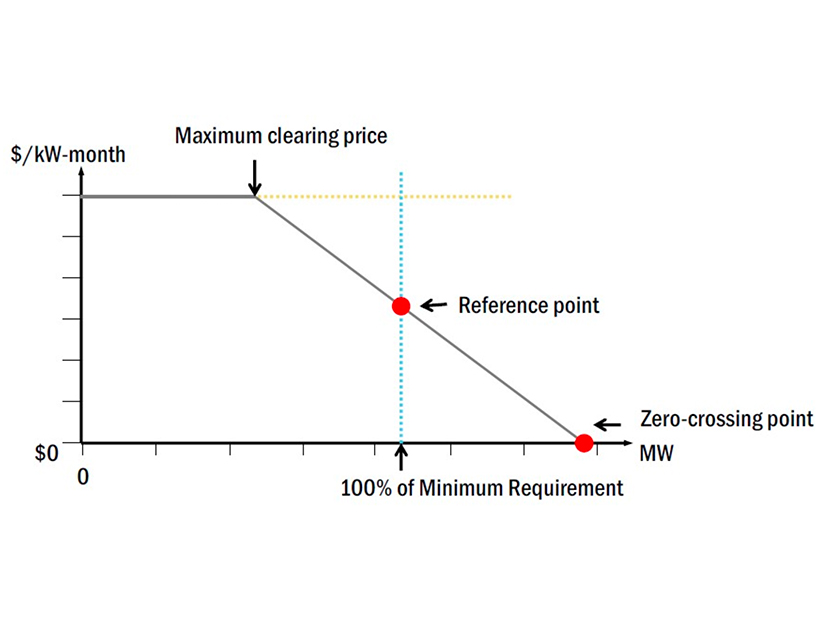FERC on Friday approved an update of NYISO’s Installed Capacity (ICAP) market demand curves, but it rejected the proposed 17-year amortization period as “speculative” and ordered a compliance filing within 14 days (ER21-502-001).
The commission said that reducing the previous 20-year amortization period “may result in unnecessarily high net cost of new entry (CONE) estimates, which will impact the ICAP demand curves.” The order drew partial dissents from four of five commissioners.
The ISO in November proposed parameters and assumptions for the ICAP demand curves for capability years 2021/22 through 2024/25, selecting the H-class frame turbine from General Electric as the peaking plant to establish the curves. (See NYISO Proposes ICAP Demand Curve Reset Values.)
NYISO’s Services Tariff defines a peaking plant as “the unit with technology that results in the lowest fixed costs and highest variable costs among all other units’ technology that are economically viable,” which includes “the number of units (whether one or more) that constitute the scale identified in the periodic review.”
New York’s Climate Leadership and Community Protection Act (CLCPA) requires state load to be served by 100% zero-emission resources by 2040, prompting NYISO to adopt a 17-year amortization period as representing the average period of years between the beginning of each capability year covered by the 2021-2025 DCR and the new law’s compliance deadline.
The Independent Power Producers of New York (IPPNY) wanted an even lower, 15-year amortization period, arguing that the proposed H-class turbine will not be able to operate beyond 2040 because of the law and that there was no evidence to support NYISO’s assertion that the hypothetical peaking facility could retrofit and operate beyond the statutory deadline.
The ISO’s Market Monitoring Unit said that a 17-year amortization period would result in “excessively high demand curves and increase net CONE between 4.8 and 10.2% depending on the zone.”
Myth and Markets
The commission also said it found NYISO’s proposal to continue to model dual-fuel capability for the peaking facility used in establishing the G-J Locality (Lower Hudson Valley and New York City) demand curve to be just and reasonable.
“Although there are no mandatory dual-fuel capability requirements in the G-J Locality, we agree with NYISO that a developer likely would include dual-fuel capability in a new peaking facility in the G-J Locality,” the commission said.
NYISO’s tariff requires that the proxy unit used to establish its ICAP demand curves reflect the resource with technology that results in the lowest fixed costs and highest variable costs among all other units’ technology that are economically viable.
In a partial dissent, FERC Chairman Richard Glick argued that “NYISO has not established that in the G-J Locality, a dual-fuel unit better satisfies that tariff provision than a gas-only unit connected directly to an interstate natural gas pipeline, which the record suggests could potentially have lower fixed costs while remaining economically viable.” He added that “the present record simply is not sufficient to answer the question one way or another. Accordingly, I would set this aspect of NYISO’s proposal for hearing.”
Though she did not join with Glick, Commissioner Allison Clements made similar arguments in her partial dissent over the proxy unit issue.
Glick also said that NYISO’s demand curve reset and its central role in its planning shows how far the ISO has moved from ordinary market economics.
“The administrative exercise of arguing about the cost attributes of a mythical power plant is about as far afield from market competition as anything I can imagine,” Glick said.
He agreed that the just and reasonable amortization period is 20 years, but he urged NYISO to consider adopting a different proxy unit or other more holistic reforms in light of New York’s greenhouse gas reduction goals.
“Although it is by no means certain that what are currently gas-fired resources will retire by 2040, it is clear that they will make up a smaller and smaller share of the resource mix. Before long, a gas-fired resource may no longer represent a likely new entrant, even when reserve margins are tight. NYISO would be well served to take a hard look at whether it makes sense to anchor its demand curve to a resource that is unlikely to enter the market and whether it should instead take steps to better align the capacity market’s principal parameters with the goals of the state in which it operates,” Glick said.
In a joint partial dissent, Commissioners James Danly and Neil Chatterjee disagreed with the majority’s rejection of the 17-year amortization period, citing the New York climate law.
“The majority cites the ‘speculative assumption that all fossil-fueled resources will cease operation in 2040,’” Danly wrote. “I find this to be puzzling. Though no one can predict the future, no one disputes that this is what New York’s statute requires.


